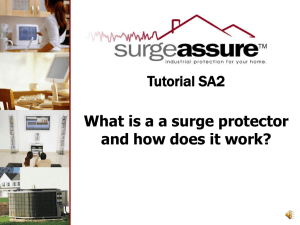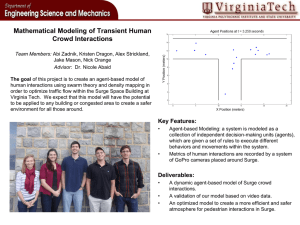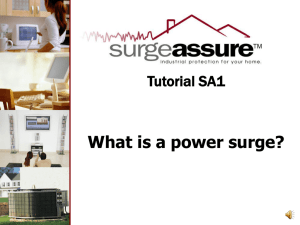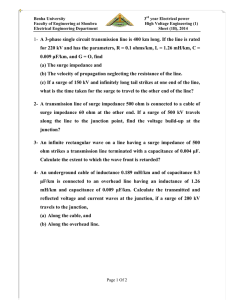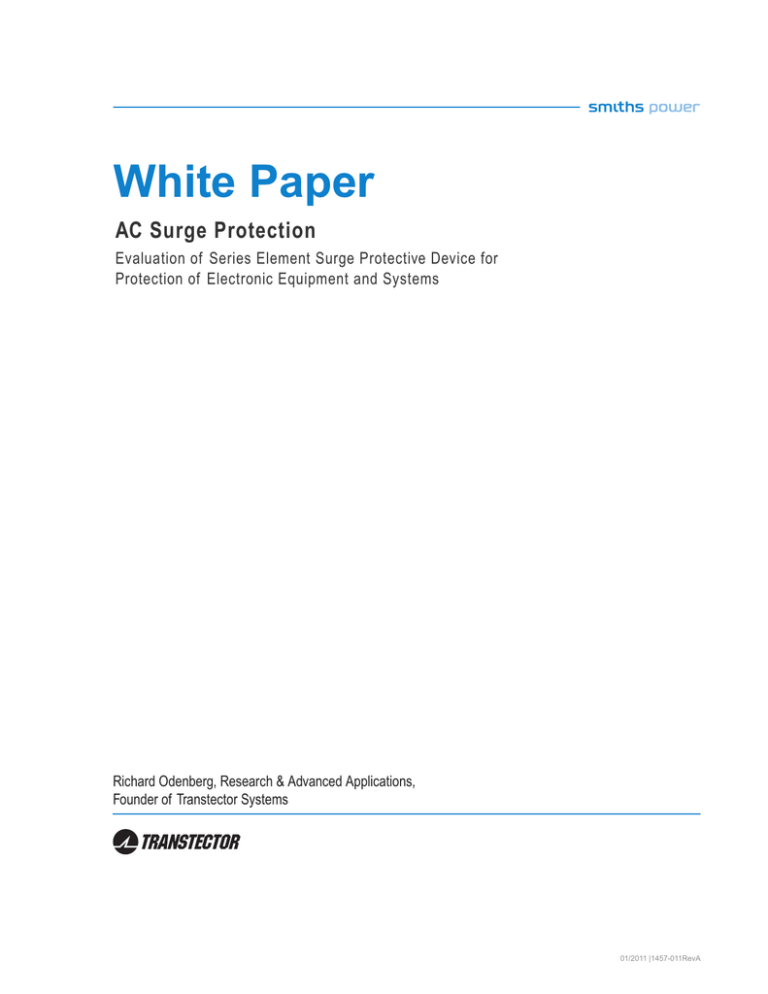
White Paper
AC Surge Protection
Evaluation of Series Element Surge Protective Device for
Protection of Electronic Equipment and Systems
Richard Odenberg, Research & Advanced Applications,
Founder of Transtector Systems
01/2011 |1457-011RevA
White Paper | Evaluation of Series Element Surge Protective
Table of Contents
Introduction
3
Application & Characteristics
4
Impedance of the AC Power vs. Telephone Lines
4
Functional Description
4
Failure Modes
5
Poor Voltage/Surge Current Coordination of S1 and S2
5
S2 Failure by Repetitive Transients
5
Load Regulation
5
Resonant Circuit
5
Load Fault Safety Considerations
5
Adding Capacitors to Filter Noise
5
Series inductor Design Parameter
6
Reliability and Life Expectancy of the Major Protection Components
6
Summary
6
Conclusion
7
Figures
Figure 1: Series Hybrid Suppressor Circuit
3
Graph 1: Impedance vs. Transient Surge Duration
7
2
Evaluation of the Series Element (Two-Port) Surge Protective Device on the
AC Power Lines for Protection of Electronic Equipment and Systems
Introduction
This report evaluates the design, protection capability and failure modes of the AC Series Element Two
Port Surge Protective Devices currently used in the industry.
In the 1980’s a number of surge protective device manufacturers found that to effectively protect the
technology of solid-state circuitry from surge voltages, they had to make a change. Gas tubes did
not adequately protect because of their slow response and high-voltage turn-on. MOV (Metal Oxide
Varistor) suppressors were not a strong option either because of their degradation characteristics. The
combination of MOV and gas tubes in a circuit, however, appeared to be an option to replace single
device technologies. This combination circuit (Figure 1) was comprised of a suppressor S1 on the AC
input and a series impedance (resistance or inductance) followed by a suppressor S2 on the load side.
Termed a Series Element Surge Protective Device (SESPD), the circuit is also known as a hybrid and as
a two-port surge protective device.
Figure 1 shows a two-port surge protective device, or hybrid, using two different surge protective technologies
(i.e. GAP or gas tube and MOV).
3
© Smiths Power 2013. All Rights Reserved.
White Paper | Evaluation of Series Element Surge Protective
Application and Characteristics
Impedance of AC Power vs. Telephone Lines
The history of the hybrid circuit goes back to the early 1970’s when its initial application was protecting
telephone lines.
These origins are important to remember when evaluating hybrid circuits because the characteristic
impedance between AC power systems and telephone signal lines differs considerably. While the
impedance of lines in telephone systems are fixed at a higher level of 600 to 1,000 ohms, the impedance
of most AC power systems is very low (a few ohms.)
Damaging surges on the telephone lines are almost always caused by lightning, producing high-voltage,
high-surge currents and very short pulse duration. (i.e. 50 μsec)
Surges on AC power lines are quite different. In addition to lightning, they are also exposed to utility
power switching surges, other user switching and internal facility switching surges. The characteristics
of these surges can be high-voltage and high-surge current, but unlike lightning, with very long pulse
duration. (i.e., 500 to 1000 μsec)
A hybrid surge protective device (SPD) used in AC power applications must protect itself not only from
surges generated from the AC line side, but from the load side as well; e.g., fuse clearing – due to faults,
computers or air conditioning systems switching on and off. A surge generated from the load side can
be almost as large as one generated from the line side. The telephone line circuit does not have this
condition because of the method of application.
In AC power systems, surge conditions can occur daily, hourly, or every minute. Lightning, on the other
hand, is seasonal and does not happen very often compared to the AC power system occurrences.
Therefore, with a hybrid SPD, the operating life in the telephone application can be long, but on the AC
power systems failure, can occur frequently.
Functional Description (Figure 1):
The S1 has generally a much higher energy capability than S2. Typically S1 can be either a gas tube
or an MOV. The S1 (a gap type) suppressor with its slower response, high current and voltage limiting
level, higher than S2, conducts; thereby taking the majority of the surge. To allow this to occur a series
impedance is installed to seperate the S1 and S2 suppressors. This impedance can be a resistor, inductor,
or a series combination of the two (depending upon the application) due to the slow response of S1. The
inductance (L) slows the surge down (stretches it out) to allow for S1 to start to conduct before S2. This
inductive impedance must be sized to pass the operating AC power on the line being protected. It should
not be too large of a value to cause high power dissipation or regulation problems. Meanwhile, S2, the
lower voltage limiting and power level suppressor (MOV or SAD) limits the remnant that was left over by
the slow response of the S1 suppressor, typically a gas tube or even an MOV.
The suppressors S1 and S2 are generally not the same technology; e.g., gas tube, MOV or silicon
avalanche diodes (SAD). Coordinating operating times and the surge current ratings between S1 and S2
are critical to a successful design.
4
Failure Modes
The following are application examples of possible failure modes of the AC Series Element Two-Port SPD
and/or equipment malfunction:
1. Poor Voltage/Surge Current Coordination of S1 and S2
If the S1 suppressor fails to turn on, the surge will pass through to destroy the S2 suppressor.
Also, if the S1 suppressor does not turn on fast enough, or at a low enough voltage, the surge
will destroy the S2 suppressor. In addition, history has shown many failures of the hybrid SPD
result from surges generated from the load (T2) rather than the line (T1). S2 on the load side is the
device that fails – whereas S1 is not affected.
2. S2 Failure by Repetitive Transients
A very common failure of S2 and the computer occurs when the computer power supply is using a
switch mode design. The failure source is a surge caused by the switching characteristics of the
power supply in combination with the suppressor system’s lead lengths, parasitic inductance and
capacitance. A single load side surge occurrence can cause complete failure, but at a minimum
repetitive load side surges will cause degradation of S2. In main and branch electrical panel
applications the surge current rating of the suppressor S2 needed on the load side is almost as
large as that of the suppressor S1 used on the line side. With the series inductor (L) isolating
the load from the line, the small load side suppressor S2 must absorb all of the surge energy
generated by the distribution system.
3. Load Regulation
Malfunction of the computer system can be caused by poor load regulation due to the series
inductor (L) and lead lengths between the suppressor and the computer limiting the current draw.
This can cause the DC output voltage of the computer’s switching power supply to change. The
end result is that the user sees the computer function properly sometimes, and at other times the
computer produces errors. In general, there is no hard equipment failure but the computer is not
always 100 percent operational and error free.
4. Resonant Circuit
The inductive, capacitive, and resistive components in the series element SPD and computer
power supply switching circuit may oscillate or resonate with each other causing sine wave
distortion. In addition, switching power supplies can cause harmonic distortion, which enhances
the resonant oscillatory problem. This tuned hybrid circuit may cause a computer to function
erratically due to the switch mode power supply turning on and off at different times. In addition,
the hybrid circuit could resonate with one computer and not with another due to a built in filter
within the AC/DC power supply.
5. Load Fault Safety Considerations
If the load should fail shorted, the series inductor in the hybrid suppressor must be designed
to handle the short-circuit current of the AC power system until the circuit clears. A hybrid SPD
should always meet the fire and safety requirement of UL 1449, which requires fault testing of the
systems based on the AC power requirements that will be used.
5
© Smiths Power 2013. All Rights Reserved.
White Paper | Evaluation of Series Element Surge Protective
6. Adding Capacitors to Filter Noise
Caution should be noted when the hybrid SPD has a filter to reduce electrical noise on the line.
Capacitors are extremely sensitive to abnormal voltage levels and may fail dramatically providing
further reason for requiring UL compliance for fire and safety.
7. Series Inductor Design Parameters
When a series inductor (L) is used to coordinate of S1 and S2, it will make this design very
difficult, due to the complex and varying voltage rise times and durations of the “real world”
surges. The best calculations can go astray since the entire situation is highly nonlinear. Most
hybrid circuits are designed and tested to laboratory waveforms (8/20) rather than the waveforms
of the everyday electrical environment.
8. Reliability and Life Expectancy of the Major Protection Components
In a design where S1 is an air gap or gas tube and S2 is an MOV or SAD, the following conditions
should be considered:
(S1 = GAP (Gas Tube, Air Gap); S2 = MOV or SAD)
A. It is widely known that after the first suppression of the surge voltage by a gas tube S1,
the gas tube begins to degrade. In addition, the gas tube or air gap shorting the AC power
line causes distortion in the sine wave. A resistor in series with the GAP S1 and MOV S2
is commonly used to help prevent this problem. Unfortunately, the resistor reduces the
effectiveness of the device’s capability to divert the surge and can produce additional
problems. For example, if using a wire wound resistor, the response time is reduced due to
inductive characteristics and the voltage limiting level is increased. This means the S2 has to
handle more energy.
B. With an inductor in series, inductive surges may be produced when a fuse upstream in the
system opens, causing computer equipment to operate erratically or fail.
C. Whether used on S1 or S2, MOVs degrade by either thermal runaway or repetitive surges.
D. Silicon Avalanche Diode have long term repeatable performance with no degradation. They
have a positive temperature coefficient, so thermal runaway is not a problem. However, if
power dissipation is exceeded, because not enough SADs are incorporated, the device will
fail.
Summary
Major issues when considing using a series hybrid SPD include:
1. Series inductor design parameters in real life vs. laboratory waveform testing (see Graph
1) – The inductors XL (impedance) will vary with the (T1) surge duration. Therefore, it can be
difficult to coordinate S1 and S2 suppression elements because real life waveform durations vary
considerably.
6
Graph 1 Impedance vs. Transient Surge Duration
2. Limited life – GAP and MOV surge components degrate with use.
3. Harmonic and load regulation problems – Waveform distortion can lead to these disturbances.
4. Resonances by inductor, capacitor – Variable lead lengths of circuits with components in
switching power supplies can cause this issue.
5. Power dissipation (S1 vs. S2) – Bi-directional surges and load generated surges can wear out
or destroy S2.
6. Load fault safety conditions (UL 1449) – The ability of the series hybrid suppressor inductor or
suppressor element to handle short circuit current during the shorting of a load or suppression
element, as well as the residual energy from the inductor following the opening of an AC fuse
upstream are vital fire and safety considerations.
Conclusion
As enumerated, the series hybrid (two-port) surge protective device may not provide adequate, safe
surge protection for today’s sensitive computer systems. Instead, it is recommended to use a parallel
SPD utilizing surge components that are not waveform duration dependant. They must also handle high
surge current without degrading.
7
© Smiths Power 2013. All Rights Reserved.
White Paper | Evaluation of Series Element Surge Protective
Please contact us for questions or further information on this topic.
Contact:
Tel: (+1) 208-772-8515
Email: Sales@ProtectionGroup.com
www.protectiongroup.com
8

